CZECH HEAD TO GERMAN MINORITY—GO HOME!
Prague, Czechoslovakia · August 3, 1945
Following Germany’s defeat in 1945, Czechoslovakia’s president Edvard Beneš pursued a policy of “no mercy” toward the roughly three million ethnic Germans and Hungarians living in his country. Beneš held the same office of president in prewar Czechoslovakia when, abandoned by his French and British allies, he was compelled to capitulate to Adolf Hitler’s territorial demands during the Sudetenland crisis in September 1938. (Sudetenland was a German-speaking region absorbed by Czechoslovakia after the collapse of Austria-Hungary in 1918.) Within days of the infamous 1938 Munich Agreement (Czechoslovakia was not even a signatory), Beneš resigned his office (he had been elected president in 1935) and went into exile as Nazi Germany and Poland (which occupied the disputed Těšín area) dismantled his country in the months leading up to Hitler’s invasion of Poland on September 1, 1939. In a series of decrees announced by President Beneš’ reborn government, since April 1945 back on Czech soil, German and Hungarian properties were to be seized without compensation to cover postwar reparations. (European political leaders had learned their lesson years ago when the German Weimar Republic successfully avoided paying required reparations after World War I.) In accordance with the “population transfer” clause in the four-party Potsdam Agreement (August 2, 1945), President Beneš issued a decree that began the expulsion of Germans and Hungarians from Czechoslovakia on this date in 1945. With the exception of a quarter million ethnic German “anti-fascists” and others judged crucial for Czech industry, 1.6 million of the nation’s “disloyal German minority” were eventually deported to the American occupation (southern) zone of what would become West Germany, and an estimated 800,000 were deported to the Soviet occupation zone in what would become East Germany. (To put these numbers into perspective, between 12 and 14 million German speakers, primarily from central and southern Europe, were relocated to Germany after the war.) Estimates of casualties (including suicides) during the Czechoslovakian expulsion range wildly, from 20,000 to 270,000 people. In 1991 Czech President Václav Havel apologized on behalf of his nation for the massacres of innocent German civilians and other outrages committed during the chaotic postwar expulsion.
[amazon_carousel widget_type=”ASINList” width=”600″ height=”200″ title=”Recommended Reading” market_place=”US” shuffle_products=”False” show_border=”False” asin=”1412852587,1403973083,0143037757,0195102673,125003356X,0521008964,0300198205,0674034597,0889225672,1300016760″ /]
German Postwar Population Upheaval and Resettlement
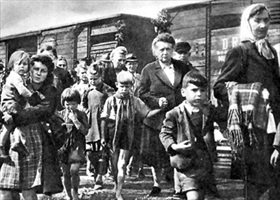 | 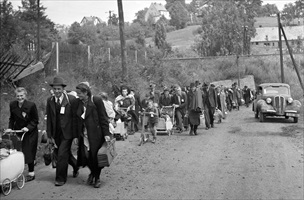 |
Left: A group of expelled Sudeten Germans. Edvard Beneš and his Czechoslovak government-in-exile pursued a two‑fold policy: (1) restore Czechoslovakia to its pre-1938 (pre-Munich) boundaries and (2) remove or at least reduce, through a combination of minor border rectifications and population transfers, the state’s German and Hungarian minorities in order to restore the territorial integrity of Czechoslovakia and establish greater national homogeneity.
![]()
Right: Sudeten Germans make their way to the railway station in Liberec, Czechoslovakia, to be transferred to Germany in this July 1946 photo. The creation of ethnically homogeneous nation states in Central and Eastern Europe was presented as the key reason for the official decisions of the 1945 Potsdam and previous Allied conferences as well as the resulting expulsions. The principle of every nation state having and living within defensible borders gave rise to a series of forced population transfers and resettlements (we know them today as “ethnic cleansing”), not just of ethnic Germans, but Poles, Hungarians, Romanians, Ukrainians, and others who after the war found themselves outside the borders of their reconfigured home states.
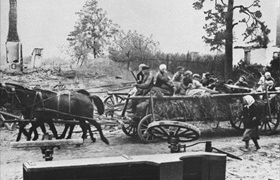 | 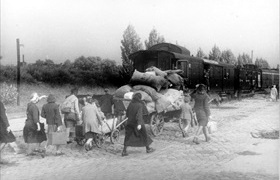 |
Left: East Prussian “repatriants” from what is today Poland drive past ruins to reach the safety of Germany, 1945. Poles believed the expulsion of Germans from Poland would avoid future atrocities like those the Nazis had inflicted on their population during the war. Polish exile authorities proposed a population transfer of Germans as early as 1941. During the war the Beneš Czechoslovak government-in-exile worked with the Polish government-in-exile toward this end. With at least 12 million directly involved, possibly 14 million or more Germans were swept up in the largest single ethnic population upheaval in European history, an upheaval that displaced more than 20 million people in total.
![]()
Right: With their modest possessions, refugees from Germany’s “lost Eastern territories” make their way to Berlin’s Pankow freight station to secure rail transportation to other parts of Germany. The postwar Polish and Czechoslovak governments characterized the forced exile and confiscation of expellees’ property as “a just punishment for Nazi crimes.” During the population upheaval over 2 million civilians, mostly women and children, died from hunger, disease, and violence (10–30 percent were killed).
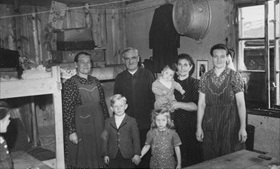 | 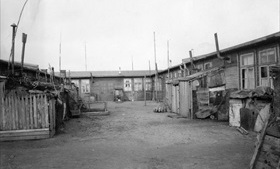 |
Left: A family, possibly from Czech Sudetenland, takes up new residence in a refugee camp in Bavaria in 1945. The expulsion of ethnic Germans created major social disruptions in the receiving German states (Länder), which were hard pressed to provide millions of new residents with decent housing, schooling, employment, and financial assistance. An estimate from 2000 suggests that as many as 20 percent of Germany’s 80 million citizens were expellees and their descendants.
![]()
Right: A photo from 1951 of barracks in a refugee camp in Schleswig-Holstein, Northern Germany, shows the poverty into which many refugees, many who were well-to-do and privileged before the war, were forced to settle.
1938 Munich Agreement and the Dismemberment of Czechoslovakia
![]()

 History buffs, there is good news! The Daily Chronicles of World War II is now available as an ebook for $4.99 on Amazon.com. Containing a year’s worth of dated entries from this website, the ebook brings the story of this tumultuous era to life in a compelling, authoritative, and succinct manner. Featuring inventive navigation aids, the ebook enables readers to instantly move forward or backward by month and date to different dated entries. Simple and elegant! Click
History buffs, there is good news! The Daily Chronicles of World War II is now available as an ebook for $4.99 on Amazon.com. Containing a year’s worth of dated entries from this website, the ebook brings the story of this tumultuous era to life in a compelling, authoritative, and succinct manner. Featuring inventive navigation aids, the ebook enables readers to instantly move forward or backward by month and date to different dated entries. Simple and elegant! Click 











